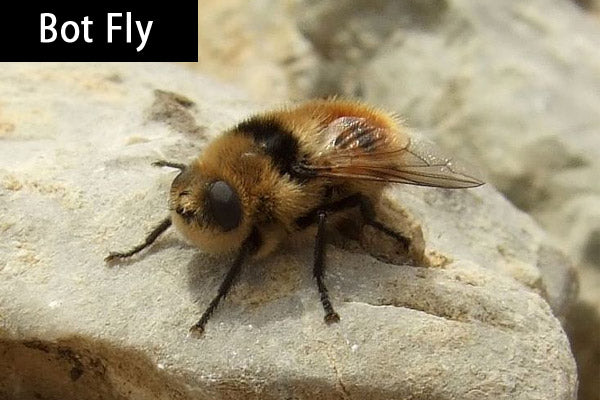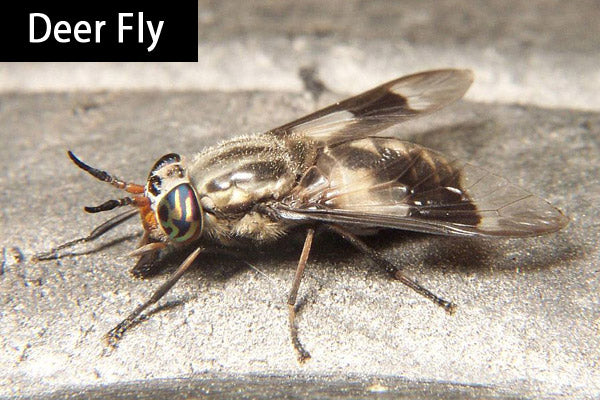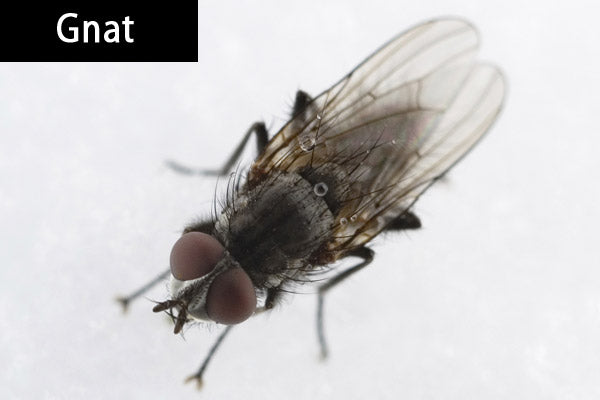Identify Your Fly: What's Buggin' You?
There are over 120 thousand different species of flies known to man. Luckily for you, only a few of these species are troublesome for your animals. WOAHH!!.. Don't go grabbin' that fly swatter just yet, there are still a couple of things you need to know first! Before saving your animals from these pesky boogers, it is critical to know which ones are the problem. This is important because a treatment that is helpful for one particular species of fly might not have any effect on another. In order to effectively control your fly, you must identify it first.
10 Types of Flies Harmful to Animals and Livestock
-
Bot Fly

"Cephenemya stimulator" by Karsten Heinrich (& G. Kothe-Heinrich) - Own work. Licensed under CC BY 3.0 via Wikimedia Commons
Description: The Horse Bot Fly is found all throughout the world and is the primary species of bot fly in North America. They go through three metamorphoses during a life cycle. A new generation of bot flies is produced every year. The Horse Bot Fly is famous for its larvae that is internally parasitic to mammals. You probably know of them by the tiny yellow eggs (nits) that the adult bot fly attaches to your horse’s inner leg and belly. The female bot fly can attach between 200 and 1,000 eggs to a horse over the course of summer.
These parasites may be ingested when the horse licks the area where the nits are located. Once they are ingested, they continue to mature into bots (maggots) and attach themselves to the walls of the stomach. It is critical to be prompt in treating horses suffering from bots before the burrowing causes irritation and infection in the host's mouth and stomach. Severe infestations may lead to problems with the gastrointestinal tract, as well as anemia.
Fly Control Product: It is important to control bot flies with a product like ProZap DyFly. To eliminate stomach bots treat your horse with Jeffers® Ivermectin, while also using a bot knife for the careful removal of the bot fly eggs.
-
Horse Fly

Description: The horse fly is one of the largest true flies, in some cases measuring over an inch in size (similar to the size of a bumble bee). The horse fly is easily identified by its dark grey body and large green-metallic eyes. The horse fly can also be spotted by the dark black markings on its transparent wings. Horse flies are very strong fliers, persistent in attacking livestock and equine with a severe bite. The horse fly can afflict immediate pain to you and your animals with their gruesome bloodsucking habits.
Fly Control Product: Protect your animals with fly sheets, fly masks, and Pro Force 50 Spot On.
-
Horn Fly

Description: The horn fly is very tiny, measuring around 3/16 of an inch in size. It is a type of blood feeding fly that preys on cattle and horses. The horn fly is often found on the shoulders, back, or stomach of its host. This particular type of fly consumes about 25 meals of blood a day, and only leaves the host to lay eggs in their feces. Studies show that these flies affect growing animals the most. With an average of almost 200 flies feeding on an individual foul/calf every day, there may be up to 15 pounds of growth deficit between an afflicted foul/calf and one that is protected from these nasty pests.
Fly Control Product: Protect your animals from horn flies by using fly sheets and B-Free of Flies- Bug Killer for Flies and Mosquitoes.
-
Deer Fly

"Chrysops callidus" by Bruce Marlin - Own work. Licensed under CC BY-SA 3.0 via Wikimedia
Description: The deer fly is classified in the horse fly family. It thrives best in damp environments. The deer fly has a light yellow and black body, with gold and black patterned eyes and dark bands across its transparent wings. The female deer fly is known for pestering equine, cattle, and livestock by delivering a gruesome bite. The purpose behind the female's bite it to acquire protein by using her saw like jaws to cut through the skin and suck blood of the targeted animal.
Fly Control Product: Protect your horses, cattle, and livestock with Permethrin based products such as Farmgard™ 13.3% Permethrin Concentrate by Country Vet.
-
House Fly

Description: If you’ve ever stepped out your front door, you know the annoyance that flies can be, not only to you, but also to your animals. The House Fly is the most commonly found fly in the world. It is responsible for almost 90 percent of the true fly population. It is known to bug humans during any outdoor activity, but also infests barns, stables, and ranches. The house fly is dark blue or black with four black stripes running parallel to its body and dark red eyes. Its wings are transparent. The pesky house fly is known for carrying more than 2 million bacteria, so it’s no wonder that it is one of the leading causes of infection and disease in animals.
Fly Control Product: Protect your animals with Prozap Fly-Die Defense and Fly Predators.
-
Stable Fly

Description: The stable fly is found in all parts of the world. It resembles the house fly, but is smaller in size. It measures around 6 mm in length. One distinct difference in the Stable Fly is that their mouth features strong jaws for biting, and it feeds on the blood of most farm animals.
Fly Control Product: Protect your animals from stable flies with Prozap Fly-Die Defense, or use Fly Predators to eliminate large infestations at the source.
-
Face Fly

Description: The face fly was introduced to parts of North America during the 1940s. The face fly looks similar to the house fly, only bigger. It measures around 8mm in length. Just like many of its close relatives, the face fly has a grey thorax and contains four dark stripes. These flies acquire protein by feeding on the blood from open wounds and secretions along the face of its host. The elimination of face flies is tricky because they reside on the animal for such a short period of time. This nasty fly can transmit disease while causing eye worms and pink eye in cattle and horses.
Fly Control Product: Aid in the control of face flies on cattle by using Davis Relief! Fly Ointment, fly masks, and Pyranha® Wipe N' Spray for Horses.
-
Mosquito

Description: The Mosquito is a small fly that has a grayish-black color. Mosquitoes have a straw-like mouth feature called a proboscis that is used in sucking blood. This insect is famous for being a vector of several deadly diseases such as Yellow Fever, Malaria, and West Nile Virus.
Fly Control Product: Protect your animals by repelling and killing mosquitoes on contact with B-Free of Flies - Bug Killer for Flies & Mosquitos, UltraShield® EX Horse Fly Control, and fly masks.
-
Gnats

Description: The name Gnat is often applied to the North American Black Fly or any other number of small flies that frequent the face and eyes.
Fly Control Product: Aid in eliminating pestering gnats by using Prozap Fly-Die Defense to repel and kill on contact, as well as No Natz™ Bug Repellent.
-
No See Ums

Description: The No See Um, also known as the Biting Midge or Sand Flea, belong to a group of very tiny flies. The female No See Ums feed on blood to gain protein. This particular bite delivers a fearsome itch known to equine as the sweet itch.
Fly Control Product: Use UltraShield® Red Insecticide and Repellent, as well as fly sheets to protect your horses.
Selected References
"The Amazing Flygun Fly Facts." The Amazing Flygun Fly Facts. N.p., n.d. Web. 18 June 2015. "Botfly." Wikipedia. Wikimedia Foundation, n.d. Web. 24 June 2015. "Deer Fly." Wikipedia. Wikimedia Foundation, n.d. Web. 24 June 2015. "HORN FLIES AND CATTLE." Horn Flies and Cattle. University of Missouri, n.d. Web. 18 June 2015. "Horse & Deer Flies." How To Identify Horse & Deer Flies. N.p., n.d. Web. 18 June 2015. McLendon Morgan, and Phillip E. Kaufman. "Featured Creatures." Horse Bot Fly-Gasterophilus Intestinalis (DeGeer). Ed. Jennifer L. Gillett-Kaufman. University of Florida, Dec. 2007. Web.
